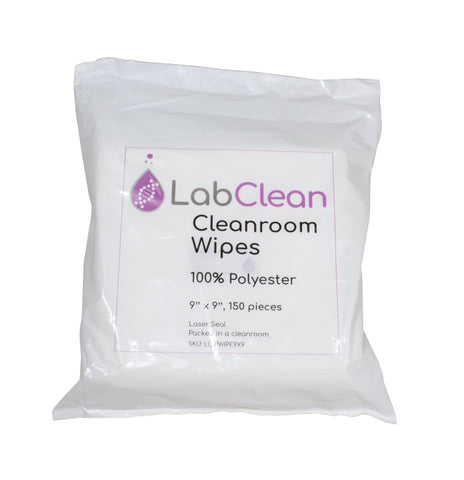- No products in the cart.
Using Polyester Wipes vs. Cellulose Blend Wipes in Cleanroom Environments
28
Sep
It's essential to select the correct cleanroom environment wipe, i.e., polyester or cellulose so that you can maintain sanitation standards. Utilizing the proper cleanroom environment wipe will help you remove any contamination and allow you to work cleanly and efficiently while maintaining the highest of safety standards.
In this article, we'll highlight the differences between polyester wipes vs. cellulose wipes and provide use cases for each type so that you can select the right wipe for the correct cleanroom environment application.
Polyester Wipes vs. Cellulose Blend Wipes
For high-performance cleanroom environments, the best options are either a woven synthetic fiber such as polyester, or a non-woven blended fiber based on cellulose.

Polyester Wipes
Polyester is a synthetic fiber made from petroleum, meaning it can naturally absorb solvents like oil, gasoline, and grease. Polyester does not readily absorb water-based solutions, although many pre-saturated options are available to improve sorbent properties.
Monofilament polyester wipes are one of the cleanest wiping materials available. The fabric is woven from smooth, single threads that are less susceptible to linting.
Polyester wipes can be cut in various edge finishes – a knife cut edge is generally the cheapest, but laser or ultrasonic sealing can be used to seal the edges and minimize the risk of linting as well. High-grade polyester wipes are also pre-washed to remove any remaining loose fibers, making these products ideal where the prevention of contamination is critical.
Typical use cases for polyester wipes include cleanroom critical environments and a wide variety of applications, including cleaning medical devices, electronics displays, instrument panels, semiconductors, and microelectronics products.
Advantages of polyester wipes:
- Highly absorbent for oils and greases
- Strong and durable
- Minimal shedding of particles
- Soft and non-abrasive
- Can be sterilized by gamma irradiation
Disadvantages of polyester wipes:
- Poor absorbency for aqueous solutions (unless pretreated for specific requirements)
- The highest-grade options are relatively expensive
In summary, polyester wipes are an excellent choice for high-performance cleaning of oils and greases, especially when avoiding contamination is critical.
Cellulose Wipes
Cellulose wipes provide excellent absorbency for water-based contamination and can be an economical alternative in many situations. However, most cellulose wipes use glues or binders to hold the fibers in place, accounting for up to 30% of some products' weight. Cleaning fluids can also dissolve many binders, resulting in contamination of the work area.
Typical use cases for polyester wipes include cleanroom critical environments such as research labs, hospitals, and electronics manufacturers.
Advantages of cellulose wipes:
- Economical
- Highly absorbent for water-based solutions
- Biodegradable
Disadvantages:
- Binders may dissolve, leading to contamination
- Subject to linting, especially when wet
- Not as strong as some other options
In summary, cellulose wipes are an economical choice for general cleaning tasks, but they can lack strength and are susceptible to leaving a residue from binder adhesive and fiber deposit.
Polycellulose Wipes
Polycellulose wipes blend the best of both worlds. A polycellulose wipe contains a blend of materials, combining the absorbency of cellulose with polyester's strength and integrity.
It's a non-woven product, consisting of polyester and cellulose fibers which are bound together by hydroentanglement. The bonding process uses fine, high-pressure water jets to entangle the fibers, producing a durable fabric. Since no artificial binders or adhesives are used, polycellulose wipes are chemically pure and do not leave residues.
The polyester component provides strength and excellent absorption of oils and greases, while the cellulose absorbs aqueous solutions and provides anti-static properties.
A blend of 55% polyester to 45% cellulose is typical, but the proportions can vary depending on requirements: increasing cellulose content gives better absorbance while increasing polyester reduces linting.
Advantages of polycellulose wipes:
- Relative low cost
- High absorbency
- Balance of good strength vs. low linting
- Good chemical resistance
- Biodegradable
- Reduces electrostatic discharges
- Can be pretreated with a variety of solvents for specific applications
- Good general-purpose wipe, but there may be a better option for specific tasks
Summary of polyester wipes vs. cellular wipes
Cellulose wipes are an economical choice for basic cleaning tasks, but when high-grade performance and elimination of contamination is essential, consider a woven polyester fabric. In many scenarios, polycellulose wipes can offer an ideal compromise because it combines the cleanliness of a synthetic polyester with cellulose's absorbency.
LabClean is a U.S.-based leader in critical cleaning solutions for cleanrooms and controlled environments. To learn more, contact us online or at 888-252-2776.

